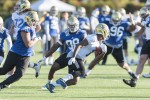UCLA football has big shoes to fill in the backfield with the program’s third-leading all-time rusher Paul Perkins graduating.
Luckily, the Bruins have three capable runners fighting to cram into those shoes: junior Nate Starks and sophomores Soso Jamabo and Bolu Olorunfunmi.
In the end, the trio will likely split action at the running back spot, presenting opponents with a variety of challenging styles.
“We all have different abilities. We all can make different moves in space, which will be tough on a lot of defenses,” Jamabo said after Wednesday’s practice. “Not a lot of teams can face three great running backs so when one of us comes out, it’s like another great one’s coming in, so it’s going to be really hard for defenses.”
The coaching staff has recognized the talents of the three backs, implementing a more run-focused approach even with the loss of Perkins.
Under new offensive coordinator Kennedy Polamalu, UCLA is emphasizing the power run game. The running backs now follow a fullback through the hole, moving quickly to the line of scrimmage before making a cut.
“(The key is) just getting used to that downhill running,” Jamabo said. “Not grabbing the ball and seeing where you’re going, but (running) downhill and making a cut off the line.”
Starks, whose high school employed a similar style, said he feels his game is suited for the power element.
“I’ve always been a downhill kind of runner, I’m a real physical guy, I love contact,” Starks said. “It’s all about getting north and south, getting those dirty yards as a running back.”
To help the backs get those yards, UCLA is also employing heavier personnel packages. Gone is the pass-oriented Y receiver spot, replaced by a more traditional tight end role – hand on the ground, adjacent to the offensive tackle.
The Bruins’ heaviest packages include two tight ends, but the coaches are still looking for the right player to occupy those spots.
“It’s a work in progress, especially since we didn’t have any true tight end in the offense for the last four years,” said tight ends coach Rip Scherer. “So we’re trying to create tight ends out of different position groups, different body types.”
Scherer said he is looking for his tight ends to be able to contribute both as blockers and receivers.
“Number one, we’re going to run the ball, so it’s got to be a position that is a really good blocking position,” Scherer said. “But at the same time … if the tight end is a factor in your passing game, I think it creates a lot of problems for defenses.”
With blocking experience from his time at the H-back position in recent seasons, redshirt senior Nate Iese has an upper hand on the rest of the tight end hopefuls.
Iese was the only player listed as a fullback on last season’s roster that received playing time. With him at tight end now, the Bruins are utilizing position conversions to fill the fullback spot as well. Former linebacker Cameron Griffin and former defensive lineman Ainuu Taua are competing for the job, bringing the type of hard-hitting physicality that Polamalu is seeking.
“Cam and Ainuu – they’re big, physical guys,” Scherer said. “If I was a running back, it’d be kind of reassuring to line up behind those kind of athletes with that kind of size and yet explosiveness.”
That combination hasn’t been lost on the running backs, who gushed about the fullbacks’ quick adjustment to the offensive side of the ball.
“They’re already used to doing that kind of hitting,” Starks said. “I really like having that extra blocker.”
Three Downs:
1. Junior defensive lineman Jacob Tuioti-Mariner has made the shift from end to tackle this spring. Defensive line coach Angus McClure presented the idea to Tuioti-Mariner in the offseason, suggesting that the 6’2” lineman’s pass-rushing game might be better-suited to the interior line positions. Tuioti-Mariner, who recorded two sacks and 34 tackles in 13 games last fall, said the most difficult adjustment has been dealing with double-teams.
2. Scherer, a long-time coach who took the tight ends job this offseason after spending the last couple years in the UCLA athletic administration, said he missed coaching while working in an administrative role.
“When (athletic director) Dan Guerrero gave me an opportunity to get in the administration, I really thought I was – I tried to convince myself I was done (coaching),” Scherer said. “But after being around this program for the first year or so – with Coach Mora and the energy and the passion, you know – I missed the relationships with the players, the competition.”
3. A second-team All-Pac-12 selection in the fall, junior safety Jaleel Wadood is transitioning into more of a leadership role on the defense, but he said he still finds it strange that he’s an upperclassman.
“It kind of feels weird because everybody calls me an upperclassman, but I’m still 19,” Wadood said. “It seems like I just got here.”
Playing safety across from sophomore quarterback Josh Rosen in 11-on-11 drills, Wadood said, reminds him of the pair’s time together at St. John Bosco High School.
“It feels like high school all over,” Wadood said. “He knows certain tendencies I have, I know certain tendencies he has, so we kind of bring out the best in each other.”
Email Cummings at mbcummings@media.ucla.edu or tweet him @mbcummings15.
